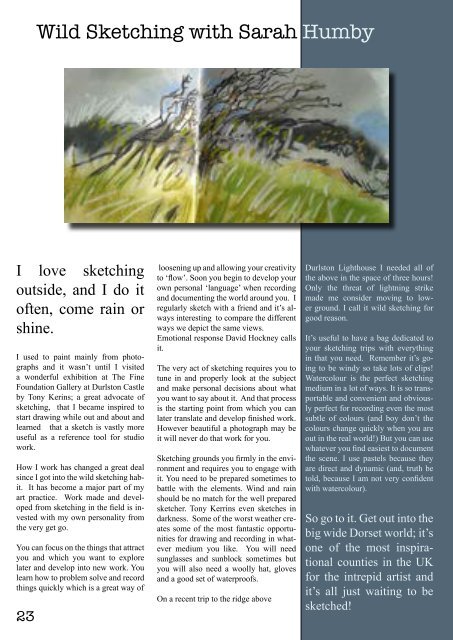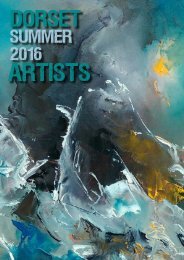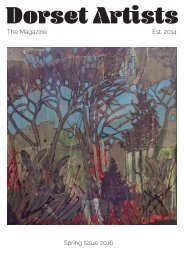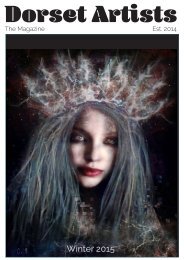Summer 2016 b
You also want an ePaper? Increase the reach of your titles
YUMPU automatically turns print PDFs into web optimized ePapers that Google loves.
Wild Sketching with Sarah Humby<br />
I love sketching<br />
outside, and I do it<br />
often, come rain or<br />
shine.<br />
I used to paint mainly from photographs<br />
and it wasn’t until I visited<br />
a wonderful exhibition at The Fine<br />
Foundation Gallery at Durlston Castle<br />
by Tony Kerins; a great advocate of<br />
sketching, that I became inspired to<br />
start drawing while out and about and<br />
learned that a sketch is vastly more<br />
useful as a reference tool for studio<br />
work.<br />
How I work has changed a great deal<br />
since I got into the wild sketching habit.<br />
It has become a major part of my<br />
art practice. Work made and developed<br />
from sketching in the field is invested<br />
with my own personality from<br />
the very get go.<br />
You can focus on the things that attract<br />
you and which you want to explore<br />
later and develop into new work. You<br />
learn how to problem solve and record<br />
things quickly which is a great way of<br />
23<br />
loosening up and allowing your creativity<br />
to ‘flow’. Soon you begin to develop your<br />
own personal ‘language’ when recording<br />
and documenting the world around you. I<br />
regularly sketch with a friend and it’s always<br />
interesting to compare the different<br />
ways we depict the same views.<br />
Emotional response David Hockney calls<br />
it.<br />
The very act of sketching requires you to<br />
tune in and properly look at the subject<br />
and make personal decisions about what<br />
you want to say about it. And that process<br />
is the starting point from which you can<br />
later translate and develop finished work.<br />
However beautiful a photograph may be<br />
it will never do that work for you.<br />
Sketching grounds you firmly in the environment<br />
and requires you to engage with<br />
it. You need to be prepared sometimes to<br />
battle with the elements. Wind and rain<br />
should be no match for the well prepared<br />
sketcher. Tony Kerrins even sketches in<br />
darkness. Some of the worst weather creates<br />
some of the most fantastic opportunities<br />
for drawing and recording in whatever<br />
medium you like. You will need<br />
sunglasses and sunblock sometimes but<br />
you will also need a woolly hat, gloves<br />
and a good set of waterproofs.<br />
On a recent trip to the ridge above<br />
Durlston Lighthouse I needed all of<br />
the above in the space of three hours!<br />
Only the threat of lightning strike<br />
made me consider moving to lower<br />
ground. I call it wild sketching for<br />
good reason.<br />
It’s useful to have a bag dedicated to<br />
your sketching trips with everything<br />
in that you need. Remember it’s going<br />
to be windy so take lots of clips!<br />
Watercolour is the perfect sketching<br />
medium in a lot of ways. It is so transportable<br />
and convenient and obviously<br />
perfect for recording even the most<br />
subtle of colours (and boy don’t the<br />
colours change quickly when you are<br />
out in the real world!) But you can use<br />
whatever you find easiest to document<br />
the scene. I use pastels because they<br />
are direct and dynamic (and, truth be<br />
told, because I am not very confident<br />
with watercolour).<br />
So go to it. Get out into the<br />
big wide Dorset world; it’s<br />
one of the most inspirational<br />
counties in the UK<br />
for the intrepid artist and<br />
it’s all just waiting to be<br />
sketched!<br />
joyce<br />
ringrose<br />
sarah<br />
humby<br />
coastal<br />
colours









